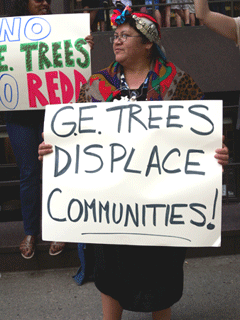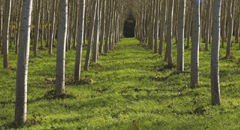GMO-Trees
Air Date: Week of May 29, 2009

Maria Tesorera, from a women’s group in Chile, protests outside the Belgian Permanent Mission in New York City. Belgium recently planted a test plot of genetically engineered low-ligning poplar trees. (Orin Langelle)
Scientists are developing genetically modified trees for the forests of the future. Ann Peterman of the Global Justice Ecology Program tells host Bruce Gellerman that these designer trees don't measure up to what a real forest provides.
Transcript
GELLERMAN: While preserving forests holds great promise for reducing greenhouse gas emissions, not all forests are created equal. There are natural forests, which are home to a variety of trees, plant and animal life. Then there are tree plantations - where a single type of tree is grown for its commercial value.
Scientists are now experimenting with tree plantations, manipulating and modifying the genes of saplings that grow in these monoculture forests - and that’s a problem says Ann Peterman. She’s executive director of the Global Justice Ecology Project.
PETERMAN: One of the main trees that they’re genetically engineering is eucalyptus. But they’re also genetically engineering poplars and pines, so those three species are pretty much the three main forestry trees that they’re genetically engineering. And they’re mainly doing it either for pulp and paper, for cellulosic fuel – in other words biofuels made out of trees – or for timber, in the case of some of the pine. So they’re genetically modifying them to enhance some of the traits. In the case of timber, they want, you know, straighter trees or less branches or, you know, if they could grow two by fours that would make them very happy. Or in the case of paper, they want to actually create trees that have less lignin. Lignin is the structure in a tree that makes it strong, that protects it against insects, disease, fungus, etc, but makes it very hard to make paper or fuel. So if they have low lignin trees, they can more easily process them, they say, into paper or fuel.
.gif)
Ann Peterman reading about the ecological dangers of genetically engineered trees at the UN Convention on Biological Diversity. (Orin Langelle)
GELLERMAN: When you say “they” you’re talking about companies.
PETERMAN: Right, I’m talking about the paper industry, the biolfuels industry, etc.
GELLERMAN: What’s the problem. I mean, they’re saying we need to be more sustainable, we need to grow sustainable products, provide for an ever-expanding population and this is good.
PETERMAN: Their argument is that this will grow more wood on less land. Less forest will be cut down because we can concentrate the amount of timber that we’re growing on a piece of land. But as we’ve seen with traditional plantations that are already developed all over the world, they do not protect forests, they destroy forests. And the reason is because plantations are worth more money than natural forests. They can get more timber out of them or they can get a specific kind of timber out of them. In a natural forest they can’t do that. So, it’s worth more money.
GELLERMAN: So what you’re saying is, it’s a driver of deforestation. They would go in and they would deforest a natural rainforest or tropical forest. And then plant these plantation forests.

Tree plantations are planted in straight rows with a single species of tree. (Photo: Andy Coulson)
PETERMAN: Exactly, and you see that in Brazil. They’ve pretty much decimated the Mata Atlantica forest ecosystem in Brazil to replace them with eucalyptus plantations. Now they’re talking about going into the Amazon and replacing parts of the Amazon with eucalyptus plantations. So, yes, tree plantations have been a huge driver or deforestation all over the world.
GELLERMAN: But a tree is a tree is a tree. I mean, if you cut down a tree and you’re planting genetically modified eucalyptus in terms of carbon, is there a difference?
PETERMAN: There is actually, there’s a huge difference. And it’s not just, of course, the carbon storage, but the biodiversity, you know, the ability of the forest to sustain populations, human populations in a way that plantations can’t. But getting back to the carbon issue, forests in tropical regions store four times the carbon of a tree plantation. So when you destroy a natural forest and replace it with a tree plantation, you have just decimated the ability of that land to store carbon. Clearly, that’s gonna have impacts on the climate, not to mention the actual act of deforestation itself has huge carbon emissions. Studies have shown at the very least twenty percent of annual carbon emissions come from deforestation and more recent studies are saying it’s probably considerably more than that.

Maria Tesorera, from a women’s group in Chile, protests outside the Belgian Permanent Mission in New York City. Belgium recently planted a test plot of genetically engineered low-ligning poplar trees. (Orin Langelle)
GELLERMAN: In Brazil they are planting to count plantation trees as forest.
PETERMAN: Yeah, they do in many parts of the world. The UN allows plantations to be considered as forest. It’s just an incredible bad definition of forest that the UN uses that allows this to happen and that desperately needs to be changed. In Brazil they call tree plantations green deserts because they’re so destructive and because they are basically devoid of any other species except the monoculture of that tree.
GELLERMAN: And where on the planet is the number one place where they’re planting genetically engineered trees?
PETERMAN: China, at this point. China’s the only place in the world where they have commercially released genetically engineered trees at this point. The U.S. is in the process of trying to figure out if they want them to be legal here, Brazil is in a similar process, they’re moving forward with it. But China is the only place where they actually have commercial plantations.
GELLERMAN: Ann Peterman coordinates work on genetic trees for the Global Forest Coalition and directs the Global Justice Ecology Project.
Links
Living on Earth wants to hear from you!
Living on Earth
62 Calef Highway, Suite 212
Lee, NH 03861
Telephone: 617-287-4121
E-mail: comments@loe.org
Newsletter [Click here]
Donate to Living on Earth!
Living on Earth is an independent media program and relies entirely on contributions from listeners and institutions supporting public service. Please donate now to preserve an independent environmental voice.
NewsletterLiving on Earth offers a weekly delivery of the show's rundown to your mailbox. Sign up for our newsletter today!
 Sailors For The Sea: Be the change you want to sea.
Sailors For The Sea: Be the change you want to sea.
 The Grantham Foundation for the Protection of the Environment: Committed to protecting and improving the health of the global environment.
The Grantham Foundation for the Protection of the Environment: Committed to protecting and improving the health of the global environment.
 Contribute to Living on Earth and receive, as our gift to you, an archival print of one of Mark Seth Lender's extraordinary wildlife photographs. Follow the link to see Mark's current collection of photographs.
Contribute to Living on Earth and receive, as our gift to you, an archival print of one of Mark Seth Lender's extraordinary wildlife photographs. Follow the link to see Mark's current collection of photographs.
 Buy a signed copy of Mark Seth Lender's book Smeagull the Seagull & support Living on Earth
Buy a signed copy of Mark Seth Lender's book Smeagull the Seagull & support Living on Earth

